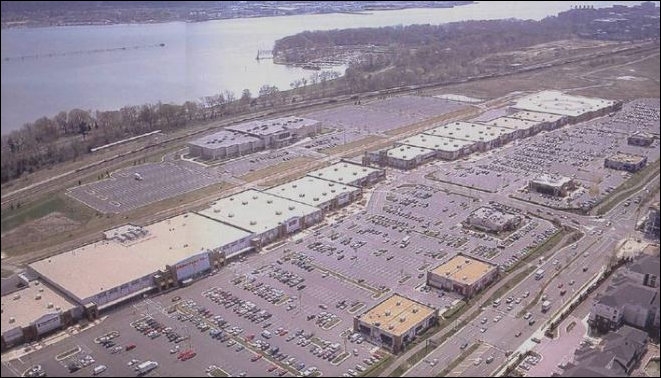
Wow, what a great way to utilize urban land almost fronting the Potomac River!
The Old Town district in downtown Alexandria is the very model of Smart Growth — it was built during the golden age of urban development when city planners believed in such things as street grids, mixed uses, and urban densities. And in recent years, portions of Alexandria’s downtown have been re-developed according to the same principles. But the city, like many of its peers, succumbed during the post-World War II era to the siren call of suburban zoning codes, and the results outside of Old Town have been dismal.
A key component of any self-respecting auto-centric suburban zoning code was a set of regulations dictating how much surface parking was required for everything from strip malls to garden apartments. It appears that Alexandria planners applied those requirements with relish.
An astonishing 10% percent of the city’s surface is covered by parking lots, a task force comprised of Alexandria residents, developers and city leaders has found. The average peak occupancy of 60 sites surveyed was 59%, reports the Washington Business Journal. Nearly 59% of Alexandria hotel visitors reach their destination by taxi, Uber, or Lyft; 52% of restaurant patrons do not drive. And some landlords are leasing their space to others to utilize excess parking.
While on-street parking serves some beneficial purposes in defining the urban fabric — parked cars create a barrier between pedestrians on the sidewalk and moving cars on the street — excess parking is destructive to the environment and urban design. Impermeable parking lots contribute to storm-water runoff. They trap solar rays and contribute to the urban heat-island effect. Parking lots consume space that could be devoted to higher-value urban uses, either buildings that enhance property taxes or parks that enhance well-being. And they fragment streetscapes, thus undermining walkability.
The task force will submit recommendations to City Council tomorrow.
Among the major changes under consideration: Setting a minimum and maximum parking standard for everyone — as opposed to the minimum-only scenario currently in place — exempting small neighborhood businesses from the parking minimum, and allowing for shared parking between businesses.
Sounds like a big improvement over the current policy, which hasn’t changed in 50 years. But personally, I would go further. Unless a compelling public need can be demonstrated to exist, eliminate all parking mandates, period. Next, reform zoning codes to make it easy for property owners to recycle parking lots into buildings. Finally, convert on-street parking to dynamically priced metered parking that varies with supply and demand. Then you’d be talking real parking reform.


